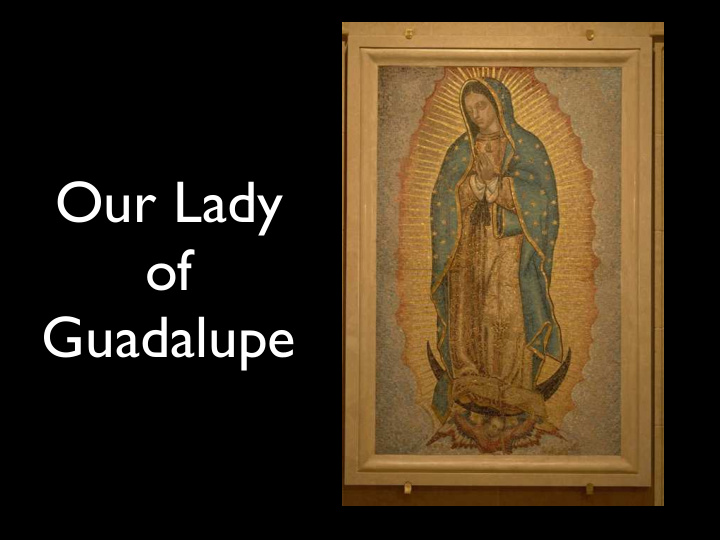



Our Lady of Guadalupe
Pope Francis sends Message to the Americas • (Vatican Radio) Pope Francis has sent a Message to the Americas to mark the Dec. 12th Feast of Our Lady of Guadalupe, who is venerated as Patroness of the American continent. The Holy Father delivered the Message during the course of his weekly General Audience on Wednesday, the eve of the feast.
The Aztec People • Worshipped many gods and practiced human sacrifice • Thought the Spaniards were gods when they arrived in 1519 • Spaniards sent Franciscan missionaries to covert the people • Mary appeared to link the world of the Aztecs with that of the Christian missionaries
The Apparitions • Mary appears 5 times • Appeared to Juan Diego twice on Dec. 9, 1531 • Appeared a third time on Dec. 10th • Appeared a fourth time on Dec. 12th • Appeared a fifth time to Juan Diego’s uncle on Dec. 12th, whom she healed • Sends Juan Diego to the Bishop, requesting that he build a shrine in her honor • Image of Mary miraculously appears on the tilma, convincing the Bishop to build the shrine
Who Painted It?
Juan Diego’s Tilma • Moved several times until making its way to its current location in the Basilica of Our Lady of Guadalupe in Mexico City • Made of a plant material that should have disintegrated by now • Has survived accidents and is perfectly preserved today • Many have been healed by praying before the image for Mary’s intercession
Symbols on the Sacred Tilma • SUN'S RAYS: The 'aureole' (brightness around the image) is a symbol attributed to God and the rays give the Sacred Image an aura of light. They appear as though they are emitted from her, based on the direction of the arrows and the wavy pattern. At that time, the Aztecs were waiting for the birth of the new sun. • FOUR-PETALLED FLOWER: This four-petalled flower is the only flower of its kind found on Our Lady's robe. It is known as the 'flower of the quincunx' - considered to be one of the highest religious and cosmogonic symbols of the Aztecs. It depicts the four movements of the sun (the four seasons) as well as the North, South, East and West united in the centre by a fifth element giving it balance and equilibrium. • HER FACE: Our Blessed Mother's face is bowed down, looking at everyone tenderly and with compassion, gazing slightly to one side as a sign of reverence and respect as native Indians considered it improper to look directly at anyone's face. The features of the face of this young goddess and mother is neither that of an Indian nor Spanish but a 'half-caste' - one who is considered mestizo, meaning a blend of races • HER EYES: There are human forms reflected in her eyes, which measure between 8-9mm. It would be impossible to paint this detail within such a tiny space and on such rough material. • HER HAIR : Our Blessed Mother's hair is loose, indicating she's a virgin maiden - married indigenous women braided their hair. • BAND (RIBBON): This band or ribbon tied in a knot signifies that she is a noblewoman with child - noble indigenous women tied a black band just above their waist to show they were pregnant. This symbol, together with the symbolism of Our Lady's hair, confirms her message to St Juan Diego - 'I am the Always Holy VIRGIN Mary, MOTHER of the true God'. • HER HANDS: Her hands are joined together in prayer, just as Europeans do, confirming her request that the Bishop build a chapel on Tepeyac Hill where she appeared. THE BROOCH ON HER NECK: In Nahuatl, the central position and the shape of this brooch with a cross signifies how important Jesus Christ is to The Virgin as she brings a message that's Christocentric. AND MORE!
The reflection in her eyes Fr. Tim Oudenhoven is a priest of the Diocese of La Crosse. After being ordained only a few months, Fr. Tim was blessed with the opportunity to photograph the actual image of Our Lady of Guadalupe in Mexico this past August in high detail. He was given a total of 4 hours over 2 nights to take these photos and he lived at the Basilica for 11 days.
Recommend
More recommend